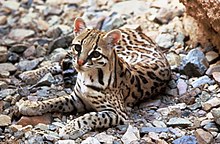The ocelot, also known as the dwarf
leopard, is a wild cat distributed extensively over South America,
Central America, and Mexico. They have been reported as far north as
Texas, and as far east as Trinidad and Barbados in the Caribbean.
North of Mexico, they are found regularly only in the extreme
southern part of Texas, although there are rare sightings in southern
Arizona. The ocelot is similar in appearance to a domestic cat. Its
fur resembles that of a clouded leopard or jaguar and was once
regarded as particularly valuable. As a result, hundreds of thousands
of ocelots were once killed for their fur. The feline was classified
a "vulnerable" endangered species from 1972 until 1996, and
is now rated "least concern" by the 2008 IUCN Red List.
The ocelot ranges from 68 to 100 centimetres (27 to 39 in) in length,
plus 26 to 45 centimeters (10 to 18 in) in tail length, and typically
weighs 8 to 18 kilograms (18 to 40 lb), although much larger
individuals have occasionally been recorded, making it the largest of
the generally dainty Leopardus wild cat genus. It has sleek, smooth
fur, rounded ears and relatively large front paws. While similar in
appearance to the oncilla and margay, which inhabit the same region,
the ocelot is larger.The coat pattern of ocelots can vary, being
anything from cream to reddish-brown in color, or sometimes grayish,
and marked with black rosettes. In many individuals, some of the
spots, especially on the back, blend together to form irregular
curved stripes or bands. The fur is short, and paler than the rest of
the coat beneath. There are also single white spots, called ocelli,
on the backs of the ears. Two black stripes line both sides of the
face, and the long tail is banded by black.The ocelot is mostly
nocturnal and very territorial. It will fight fiercely, sometimes to
the death, in territorial disputes. In addition, the cat marks its
territory with urine. Like most felines, it is solitary, usually
meeting only to mate. However, during the day it rests in trees or
other dense foliage, and will occasionally share its spot with
another ocelot of the same sex. Males occupy territories of 3.5 to 46
square kilometers (1.4 to 18 sq mi), while females occupy smaller,
non-overlapping territories of 0.8 to 15 square kilometers (0.31 to
5.8 sq mi). Territories are marked by urine spraying and by leaving
feces in prominent locations, sometimes favoring particular latrine
sites. Ocelots hunt over a range of 18 km2 (6.9 sq mi), taking mostly
small animals, including mammals, lizards, turtles, and frogs, crabs,
birds, and fish. Almost all of the prey that the ocelot hunts is far
smaller than itself, with rodents, rabbits, and opossums forming the
largest part of the diet. Studies suggest that it follows and finds
prey via odor trails, but the ocelot also has very good vision,
including night vision.Ocelots typically breed only once every other
year, although the female may mate again shortly after losing a
litter. Mating can occur at any time of year, and estrus lasts from
seven to ten days. After mating, the female will find a den in a cave
in a rocky bluff, a hollow tree, or a dense (preferably thorny)
thicket. Gestation lasts 79 to 82 days, and usually results in the
birth of only a single kitten, with its eyes closed and a thin
covering of hair. Litters of two or three kittens also occur, but are
less common. The small litter size and relative infrequency of
breeding make the ocelot particularly vulnerable to population loss.
Compared with other small cats, ocelot kittens grow quite slowly.
They weigh around 250 grams (8.8 oz) at birth, and do not open their
eyes for 15 to 18 days. They begin to leave the den at three months,
but remain with their mother for up to two years, before dispersing
to establish their own territory. Ocelots live for up to 20 years in
captivity.Like many wild cats, they are occasionally kept as pets.
Salvador Dalí frequently traveled with his pet ocelot Babou, even
bringing it aboard the luxury ocean liner, SS France. Musician Gram
Parsons kept an ocelot as a pet in the back yard swimming pool area
of his family's Winter Haven, Florida, home during his teens, in the
mid-1960s. The Moche people of ancient Peru worshipped animals and
often depicted the ocelot in their art.

No comments:
Post a Comment